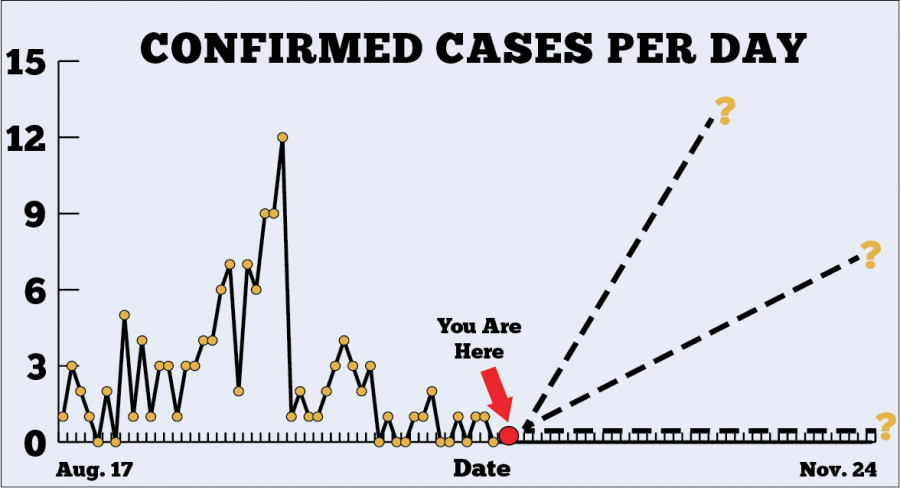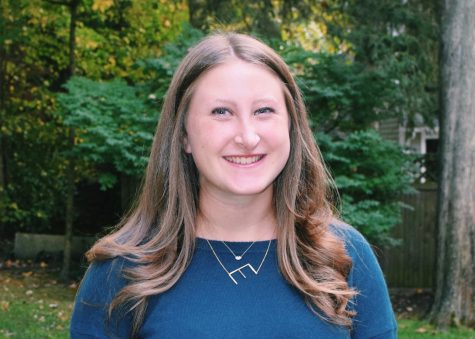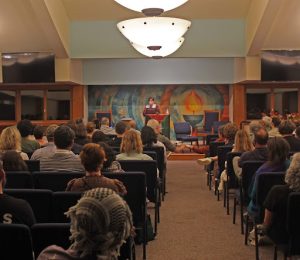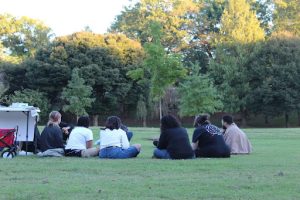University sees drop in coronavirus cases
October 8, 2020
On Oct. 6, the university reached the halfway point of the fall semester with the coronavirus largely under control. Despite the encouraging figures, the fate of the second half of the semester is still very much in the students’ hands.
Following long-standing fears from students that the university might send them home at any time due to a failure to contain COVID-19, the university’s progress in managing the virus has largely diminished this possibility. As of publication, there have only been eight new confirmed positive COVID-19 cases on campus within the last two weeks. In viewing the bar graph on the COVID-19 dashboard, there is a clear downturn in the number of positive cases since the beginning of September.
Vice President for Campus Life Penny Rue attributes this downturn in cases to students’ recognition of the importance of abiding by safety measures.
“We are thrilled that students have really gotten the message about how to keep campus safe — wearing masks, staying six feet apart, and washing hands frequently,” Rue said. She adds that students have been compliant with isolation and quarantine, as well as with the random testing program.
The university has now conducted 2,317 asymptomatic sample tests, which have resulted in 13 total positive cases, a positivity rate of 0.6%. Among over 1,000 tests conducted in the last two weeks, there have been zero positive cases, which Rue says is “outstanding.”
Dr. Joanne Clinch, clinical director for Student Health Services (SHS), echoed Rue’s statement about our community’s willingness to abide by safety measures, but also attributes the downturn to various other factors, including students’ participation in the SneezSafe symptom reporting app.
“Students’ participation in using the SneezSafe app to provide information about their symptoms and/or a possible exposure to COVID-19 has allowed the Student Health Service to connect these students to care, testing and when appropriate, isolation or quarantine,” Clinch said.
She adds that the university’s contact tracing system has been effective in helping to identify students who have been exposed to someone with COVID-19. This way, they are able to immediately quarantine those individuals to lower their risk of transmitting infection to others during the time they would be contagious, which Clinch notes can be two days before symptoms develop.
“The ability to rapidly identify people with infection, [isolate] those individuals, identify their contacts and place them in quarantine helps us to ‘box in’ the virus and reduce transmission,” Clinch said.
She also encouraged students to continue reporting positive COVID-19 tests to SHS so they can guide them on appropriate isolation and begin contact tracing.
Though the containment of the virus should come as positive news to the university community, officials warn that students should not become complacent in their protective efforts while the virus is still present at Wake Forest.
“While it is tempting to ‘let our guard down,’ doing so would increase the number of cases in our population,” Clinch said. “As we have seen from other universities, cases of COVID-19 can rise quickly if we are not careful.”
Rue also notes that if we do not stay vigilant in abiding by safety measures, there remains the possibility for the implementation of harsher restrictions.
“Should students lessen their protective measures, with our diagnostic and random testing, and our contact tracing, isolation and quarantine, we will be able to detect asymptomatic spread and tighten our restrictions to orange if needed,” Rue said.
Judging by the university’s progress in controlling the virus so far, it is evident that students are willingly abiding by public health guidelines. But as the weather turns colder, students worry about the university’s ability to provide them with dining and study spaces should the use of tents no longer remain a possibility. While Rue said she shares this concern with students and that the university is looking into ways to provide more spaces for studying and dining, she did not offer any concrete plans or proposals that accommodate this need.
This is a new challenge the pandemic brings, and navigating this shift in procedure will be tricky. According to Clinch, and as is consistent with other scientific findings, outdoor gatherings are generally considered safer than those held indoors because the air movement outdoors significantly reduces the virus’s ability to infect others. Clinch recommends that students utilize outdoor spaces to gather as long as the weather allows, but reminds them that indoor gatherings can be considered safe if managed properly. This would include wearing masks, especially when not actively eating or drinking, and maintaining appropriate distance. It is worth noting that students and professors have been able to gather inside in classrooms, albeit in smaller numbers, since the start of the semester.
But while more formal settings like classrooms require that individuals wear masks, Clinch says it is just as important to wear masks in casual settings, such as with friends. According to the CDC, the majority of individuals who become infected with COVID-19 when they do not wear masks and are within six feet of others who are infected with the virus, even if they are not showing symptoms.
“It is important to do this, even when we are with friends, when wearing a mask may feel odd or unnatural,” Clinch said. “We tend to see people get sick during the times they are just hanging out with friends, but are not wearing a mask. This will be particularly important during cold weather, when respiratory viruses like the flu and COVID-19 are more prevalent.”
There is also evidence to show that the virus can spread to others who are further than six feet away, which Clinch says normally occurs in smaller spaces that are poorly ventilated and where an infected individual is speaking loudly, breathing heavily or singing.
“With bars, restaurants and fitness centers reopening in N.C., it is important for students to understand the risk of those settings,” Clinch said. The risk is much higher if masks are not worn.
Not surprisingly, COVID-19 is impacting all aspects of campus operations, including the university’s decision-making with regard to scheduling. With the release of the Spring 2021 academic schedule on Oct. 2, students learned that the semester will start and end one week later than usual.
“The later start date follows guidance from our infectious disease specialists,” Rue said. “There will likely be a spike in cases in many places over the holidays due to travel and family gatherings. Creating a few weeks for those cases to die down before returning to campus will help us get off to a strong start.”
The omission of the traditional week-long spring break is another effort to limit travel and thereby a spike in cases.
But the most glaring consequence of a school year controlled by COVID-19 has undoubtedly been the limitation of social interactions on campus. Though this has been a difficult change for students to accept, Rue highlights a potential silver lining in restricting gatherings to smaller numbers.
“Students tell me that they are hanging out with a smaller number of friends and going deeper — having more meaningful conversations,” she said.
The hope is that, despite the limited opportunities students will have to interact with each other this year, they will still find meaningful ways to connect and embrace the now rare on-campus college experience, and, of course, “show Humanitate.”













